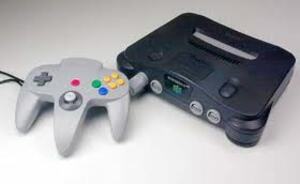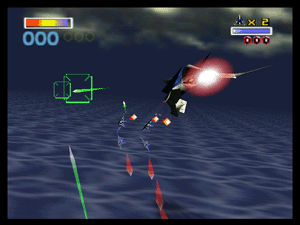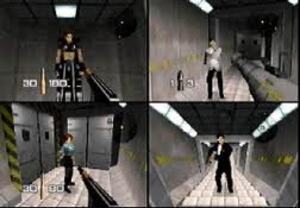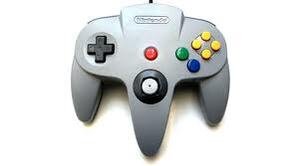
Looking back on the Nintendo 64, there are plenty of subject areas that warrant exploration. As a console, the N64 was a trend-setter that pushed the boundaries and expectations of gaming experiences. This status as a technologically advanced and experimental console was both a blessing and a curse, as it enjoyed loyalty and enthusiasm from gamers who bought into its ethos, while also suffering the backlash as certain eccentricities drove some gamers away. The negatives meant that the N64 sold significantly less units than the SNES, and Nintendo surrendered the market lead to the Sony PlayStation. Despite this, it’s a console remembered by many with fondness, and the bold design decisions that Nintendo took with the N64 have influenced and inspired various trends in modern gaming. This article will touch on three of these major innovations, and why they should be celebrated.
Polygons galore
Subscribe to Nintendo Life on YouTube841k
It’s hard to believe that it’s been 15 years since the Nintendo 64 was launched in North America until, perhaps, you fire up your favourite game from the console. It’s immediately striking that, graphically, the N64 arguably doesn’t stand up to modern standards as well as some 16-bit games from the Super Nintendo era. While pixel-based titles retain retro appeal, the early 3D polygon models evident on the N64 often look crude and ‘blurry’ by comparison. This may all sound like a negative, but it’s actually an indication of the bold step that Nintendo took with its 64-bit console, and judging these graphics by modern standards doesn't give a fair reflection of the impact that they had on contemporary gamers in 1996.

Although earlier consoles had dabbled with 3D graphics, Star Fox on the SNES being a notable example, the shift in graphical fidelity on the N64 cannot be emphasized enough. By dropping pixels in favour of polygons, Nintendo set a new standard for gaming graphics. Launch title Super Mario 64 was the perfect example of what the graphics processor could do, allowing Shigeru Miyamoto to create a Mario experience within a fully realised 3D environment. Even simple acts like rotating the camera were a novelty, and to gamers who had previously enjoyed 2D pixel-based games, Super Mario 64 represented a whole new world.
On the negative side, this technology was new and suffered from limitations. Combine this with the restricted space on the N64 cartridges, and developers faced significant challenges achieving the best visual results. Despite this, the Nintendo 64 brought extensive 3D environments into the gaming industry, astonishing gamers at the time and laying the foundations for future generations of home consoles.
New gaming experiences
As we’ve shown in our most memorable N64 games poll, this console has a legacy of definitive titles that have, arguably, had a major influence on modern gaming trends. From a Nintendo-only perspective, titles such as The Legend of Zelda: Ocarina of Time and the aforementioned Super Mario 64 demonstrated that Nintendo’s biggest franchises could become 3D gaming experiences. There were exciting new directions, also, with Paper Mario being a prime example of a Nintendo title that was inconceivable on past generations of hardware. Upgrades of well known SNES titles also bore ‘next-generation’ hallmarks of superior graphics, with Star Fox 64 (known as Lylat Wars in Europe) being an example of the significant enhancements over its predecessor in the series. Titles developed by Nintendo generally made excellent use of the technology, with Wave Race 64, to take one example, introducing impressive water and weather effects such as fluctuating waves and the use of fog on more atmospheric tracks.

Other developers did step forward, none more so than British developer Rare, that worked under an exclusive publishing agreement with Nintendo at that time. The output from Rare for the N64 was substantial in quantity as well as quality. Titles such as Banjo Kazooie and Conker’s Bad Fur Day utilised the 3D environments possible on the console to good effect. It's perhaps Goldeneye 007, though, that carries the greatest legacy for the acclaimed developer, as it's often credited with revolutionising the FPS (first-person shooter) genre on home consoles. Not only did the graphics engine introduce features such as weapon zooms and context sensitive injuries, but also brought multiplayer gaming to the fore. It is common for happy recollections of Goldeneye 007 and its spiritual successor, Perfect Dark, to revolve around split-screen multiplayer with friends. It is a gaming experience with an almost legendary status, setting the tone for FPS multiplayer gameplay that, in the fullness of time, would become an online affair.
It is interesting that, statistically, the N64 had a low number of game releases in comparison to previous Nintendo consoles. Despite this, the number of top quality titles cited by fans of the console is significant, making any debate about the ‘best’ N64 games a fierce one. The influence of some of the titles highlighted can be seen even in the current generation of console games, not to mention two notable re-releases on the 3DS.
The joy of analogue
Our final area of focus to celebrate the legacy of the Nintendo 64 is its controller. The design isn’t perfect, but at the time it was a revolution. The four ‘C’ buttons enabled unprecedented camera control, particularly important for players exploring a vast 3D landscape. The shape necessitated a trigger button, and it was a controller that felt unlike any that had come before.

The key development on the N64 controller was the analogue stick. It wasn’t the first of its kind, not quite, but it set trends as it was the primary control mechanism, rather than an optional extra. The nature of the games on the console meant that this analogue stick was mandatory, providing a natural means of control and movement for the 3D gaming that the console was pushing. In terms of the innovations that we’ve referred to in both graphic design and the memorable gaming experiences borne from the technology, none of these would have functioned properly without the analogue stick.
It would be remiss, when remembering the N64 controller, if we failed to pay due homage to the Rumble Pak. It was a bulky accessory that clipped onto the controller, but brought the idea of haptic feedback into mainstream gaming. The effect of this add-on was particularly memorable in arcade-style titles, with the device going into meltdown after boss battles in Star Fox 64, in particular. It was a trend-setter, with rumble feedback quickly becoming a common feature in console controllers.
Innovation and wonder
The bold design decisions that Nintendo took with the N64 have influenced and inspired various trends in modern gaming
These three areas, we hope, touch on the essence of what made the Nintendo 64 the technological powerhouse of its generation, and a fondly remembered console today. The console had its fair share of problems, such as the expense and limitations of the cartridge medium, but its legacy and influence on modern gaming is secure. We should be grateful for the innovation shown in the N64, and we suggest that anyone who experienced this console in its prime should fire up their favourite game this week, and raise their glass to 15 years of memories.
Keep checking Nintendo Life all of this week for more Nintendo 64 celebrations, such as a look at some missed opportunities on the console, the potential for bringing more N64 games to the 3DS, and a staff roundtable discussing its legacy.





Comments 45
I never had a rumble pack... Just a lot of messed up analogs
What a great, great console. I had many great experiences with it... After all, it was my first console! However, if I had to pick my favorite 64 game, it'd be Paper Mario, without a question. I must have cleared it at least 10 times
oh man i thought i was first
Greatest console ever!
would be good if they brought goldeneye64 to 3ds.the wii one was good but to have the original with better looks etc would be topnotch★
I love you N64
I still have mine with working anolog sticks! I'm goona play some Smash Bros. And buy Goldeneye.
I love the N64 because it uses cartridges. I like them more than discs because there are (almost) no loading times, they don't scratch so easily and they last forever. N64 games are often still in perfect condition after all these years while used CDs/DVDs have lots of scratches and scuff.
"By dropping pixels in favour of polygons, Nintendo set a new standard for gaming graphics."
I don't know about that - maybe for consoles, but it wasn't exactly a new thing for PC gaming.
After owning a SNES I'd completely skip the next two console generations, so I really only ever got to play a N64 at friends' houses. I have vague memories of playing Goldeneye and Pokemon Snap, but that's about it. I've read a bit about it lately, and I wish I'd had the chance to play it more back in the day!
OVERRATED!
N64 definetly had some nice games, but PS1 was just so much better.
Happy anniversary n64, nonethless.
I remember the first time I held an N64 controller... I had NO idea where to put my hands, I would later find out that the controller would fit the Zelda control scheme like a glove.
Yes, well all know the PS1 was far better than any of the crap this system poured out, but this isn't a Sony vs. Nintendo article. At least try and appreciate the N64
The article's first point is actually why I, in general, prefer the 16 bit consoles over the 32/64 bit consoles for retro gaming: The 16 bit consoles were the pinacle of 2D sprite-based gameplay and graphics, while the 32/64 bit consoles were the first shaky steps into 3D polygon-based gameplay and graphics and therefore the games have mostly aged poorly.
Also, the GameCube controller is SO much better than the N64 controller.
having the mic for Hey You Pikachu! was a good idea. the ps1 may have had good graphics for its time, but how many ps1 games can you think of off the top of your head compared to nintendo 64? barely any. me, i only know of final fantasy and dragon quest for ps1. n64 well, to many to count!
Happy Birthday the Nintendo Sixty-four!!!
The thing was built like a tank. I still have the same one I got when they first came out and it still works fine.
I have a lot of respect for the N64.
@zezhyrule
I said N64 had lots of good games. Isn't that aprecitation enough? N64 is by no means a bad console it just has some glaring laws which are hard to ignore.
@BulbasaurusRex
Agreed
The N64 Pikachu was very beautiful!! Isn't it?
http://www.ncsx.com/www/ncs073100/pikachu_n64_original.jpg
Can't say I have any fond memories of the N64. Wish I could say I had the N64 instead of the PSX.
F-Zero X was spot on with the analogue. A triumph of video game controllability if there ever was one.
I got the N64 on launch day being such a huge fan of the NES and the SNES I didnt even think twice when the N64 and the PS came out. Sadly though I traded mine in when the Gamecube came out one of the stupidest things I did when it comes to gaming. Lucky for me I just picked one up for 20 bucks a few months ago so I can once again play some N64 goodness when I get the hankering.
i remember my parents buying this for me and my brothers way back in the day. the first game we ever owned for it was wayne gretzky's 3D hockey. i remember never beating the game, just starting fistfights with the npc's on that game.
I can't believe it's been 15 years already!
It seems like yesterday when we found that big box under the christmas tree and my brother and I [though in my case, it was more of a "do as he does" reaction] started shouting "OMG OMG NINTENDO 60-444444444444!"*
*Competely unrelated to that video.
Wow, 15 years and look how far we've come? From pixels to polygons to HD in such a short amount of time!
N64 still has some of the best games ever made and you know it's true since there have been remakes and rereleases of those N64 games.
I put sooo many hours into goldeneye, mario 64, mario kart 64 and ocarina of time. This console didn't have many games, but it was probably one of the biggest leaps forward between generations of consoles, and firmly secured Nintendo's reputation as innovators.
I eventually sold my N64 to buy a chipped PS1 just to play Tekken and Tony Hawk. Ahhh regret
Great console, I had to swing back and forth between this and ps1.
best console ever, think ima go and play it right now!
The problem with the PSX though, is the games are now pretty unplayable thanks to DIRE load times.
N64 fo' life.
Happy Birthday, N64. This is easily my favorite console of all time, because I like the old graphics and it has some of my favorite games of all time, like Ocarina of Time, Mario 64, and Paper Mario.
Well, seeing as it's the 15th anniversary, I think I'm going to purchase a Nintendo 64 from eBay. Can't wait
I play videogames since Atari era and for me Nintendo 64 is a good console, but also is the most poor home console launched for Nintendo ever. My rank for Nintendo home consoles: SNES >>>>> GC > WII > NES >>>>>> N64.
SNES FTW !
this is my first gaming console! my first love!
I just didn't care much for the Nintendo 64. Aside from a few amazing 3D platformers and the two Zelda titles, not much interested me on this system.
I never owned one myself, I was more of PC gamer after the SNES era. So I skipped both N64 and PSOne.
@Expa0: Overrrated my . This the console the revolutionized 3D gaming. If you like 3D games in any way shape or form then you owe that to N64. Do a little proof reading before you post; the PS1 was the system with the glaring flaws.
@Corbs: I didn't realize you had such poor taste in gaming. What gives?
@doma: And the fact that they sucked to begin with. The graphics were so awful on the PS1. Textures that wobbled and warped, 5 foot draw in distances on some games, and yes those god awful load times.
When the N64 came out I was too young to have money and too grown up to have it bought from my parents, so I turned to PC gaming first and pirated-PSX some year later.
Anyway I was given the chance to see Link and Mario's firsts steps into 3D... and I felt like a betrayer. I remember me playing Spyro (which was a great game) thinking of Super Mario 64 all the time.
Today, even with Mario Galaxy and Twilight Princess I sometimes miss poor Spyro too.
@Shock_Tart wayne gretzky's 3D hockey was the funnest ice hockey game ever made (despite the rubber band AI). It was so fun playing with friends with hilarious animations, I still play it to this day.
Happy anniversary N64, you are my favorite console and made growing up that much better.
I was never lucky enough to own a N64. As far as I know they were never available in South Africa. I was a child of 8 and 16bit. I loved, and I mean LOVED my Megadrive. I found the graphics on the PS1 upsetting for the most part (never actually saw an N64 in action). They were ugly to my eyes. Years later, however, through the joys of emulation, it was titles like Starfox 64 and Ocarina of Time that brought me back into gaming.
So thanks N64, you brought back my passion for games, opened my wallet to Nintendo (and Sony), and most recently brought me to a point of starting to make my own games.
And now I get to buy those old favorites for my 3DS!
Like so many others, this is still my favourite ever console. I bought it for the technological innovation in 1997, I keep playing it for the wealth of top quality games today. Sublime.
@TheDarkness
Yes, because obviously no one would've even tried 3D graphics by this day if not for N64 >_<
Also 2D > 3D
After getting enough stars to reach the end in Super Mario 64 and watch the ending credits roll I thought to myself:
@DrCruze: Not really. Which is why you rarely ever hear about people playing PS1 games again. They are all labeled "good at the time." The whole reason Nintendo can roll out N64 games again is because they are timeless.
@expa0: I don't recall the PS1 having a whole lot of 2D games (other than Symphony of the Night which is one of 3 PS1 games worth mentioning these days.)
Happy Birthday Nintendo64!
I did prefer the PSX, but the N64 was still an awesome system. I don't think N64 games (or a majority of PSX games for that matter) have aged badly at all. If the games were good back then, then they have at least some merit today.
Conker's Bad Fur Day was reason enough to own this system. Conker's multiplayer was waaay more fun than Goldeneye's.
I wasn't bothered about the N64 at the time, even though I could and should have bought one, I remember my nan gave me £100 for my birthday so that I could buy whatever I wanted. I just spent the cash but I now regret not buying the N64 with that money.... If I could turn back time.
Show Comments
Leave A Comment
Hold on there, you need to login to post a comment...